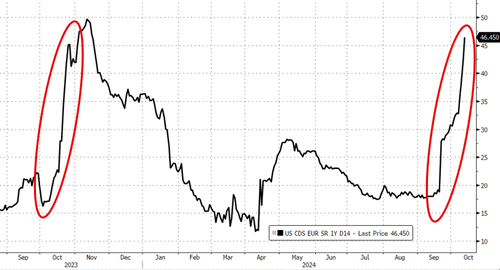Authored by Tom Ozimek via The Epoch Times,
The International Monetary Fund (IMF) has issued a stark warning about the rising tide of public debt in countries across the globe, with the United States standing out due to its persistent fiscal deficits and mounting spending pressures.
The IMF’s latest Fiscal Monitor report, released on Oct. 15, projects that global public debt will exceed $100 trillion in 2024, equal to about 93 percent of global gross domestic product (GDP), and could approach 100 percent of GDP by the end of the decade. The United States, in particular, faces significant risks if fiscal policies are not adjusted urgently.
The report emphasizes that countries, including the United States, need to address debt risks with carefully crafted fiscal strategies.
It warns that debt levels could be worse than anticipated due to large spending pressures, sizeable unidentified debt, and overly optimistic debt projections.
Unidentified debt, which refers to liabilities that do not appear explicitly in budget documents—such as contingent liabilities, losses at federally-owned enterprises like the U.S. Postal Service, and other off-balance-sheet obligations—poses a significant risk to debt sustainability, according to the IMF.
“There are good reasons to believe that future debt levels could be higher than currently projected,” the report’s executive summary states, highlighting that actual debt-to-GDP ratios three years ahead tend to be about 6 percentage points higher than originally forecasted, on average.
The IMF attributes the potential underestimation of debt levels to several factors, including a political climate increasingly favoring higher government spending. This spending is being driven by concerns around security, an aging population, and the push to invest in green transitions.
“Rebuilding fiscal buffers in a growth-friendly manner and containing debt is essential to ensure sustainable public finances and financial stability,” the report urges.
In a related blog post titled “Global Public Debt Is Probably Worse Than It Looks,” IMF economists assert that current efforts to curb debt growth are insufficient. Delays in fiscal actions, they argue, will lead to even higher costs and greater risks.
“[E]xperience shows that high debt and lack of credible fiscal plans can trigger adverse market reaction, constraining room to maneuver in the face of turbulence,” the economists wrote, emphasizing the need for proactive measures such as paring back spending.
The IMF’s analysis shows that planned fiscal adjustments—such as reducing spending by 1 percent of GDP over six years—are insufficient to stabilize debt. Instead, a cumulative tightening of 3.8 percent of GDP is needed to significantly cut debt levels, the economists contend, with the effort required in the United States being “substantially greater.”
Without substantial fiscal adjustments, U.S. debt will continue on an unsustainable path, the report warns. The country faces mounting spending demands, largely due to health care costs, aging populations, and defense needs, all of which are exacerbated by growing geopolitical tensions.
The IMF identifies reforming mandatory spending programs, such as Social Security and Medicare, as a crucial step. These programs account for a large and inflexible share of the U.S. budget, and reforming them could help rein in expenditures. Besides spending cuts, the IMF suggests that the United States could raise revenues by raising taxes or removing tax exemptions.
The IMF’s newly developed “debt-at-risk” framework—a tool used to estimate potential debt outcomes under different economic conditions—indicates that U.S. public debt could rise sharply under adverse scenarios.
Chapter 1 of the IMF report notes that, for “systemically important advanced economies such as the United States, in which the primary deficit is the largest driver of debt-at-risk, three-year-ahead debt-at-risk is estimated to exceed 150 percent of GDP, 20 percentage points higher than the baseline debt projection in the October 2024 World Economic Outlook.”
Stronger fiscal governance is also essential, according to the IMF, which describes it as “key to mitigating the buildup of unidentified debt and containing debt vulnerabilities.” Countries with better fiscal governance—marked by budget transparency and adherence to fiscal rules—tend to have lower levels of unidentified debt, even during times of financial stress.

